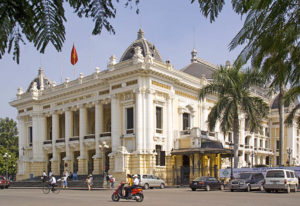
Hanoi’s 1911 Opera House is a prime example of the city’s French colonial architecture. Photo by Dennis Cox/WorldViews
In this post and the next, Contributing Writer Robert Waite recounts his recent journey to Vietnam, the country that helped define a generation of baby boomers.
Forty five years after the fall of Saigon, which effectively ended the more-than-a-decade-long Vietnam War, a visit to Hanoi still stirs emotions, whether you were pro- or anti-war in the 1960s and ’70s.
Yet even as long ago as 1997, when I last visited Vietnam, the majority of Vietnamese — born after the war — seemed to hold few if any grudges against Americans.
Our roving correspondent, himself a baby boomer, delves into the war history but also the sights and experiences that make Vietnam one of the most intriguing countries to visit in Southeast Asia today.
First up are the capital, Hanoi, and beautiful Halong Bay. Next up are Saigon (Ho Chi Minh City) and surroundings.
By Robert Waite
First of a two-part series:
Hanoi – For most Boomers, the prospect of a visit to Vietnam triggers a deep emotional response. For some, it was a place where they served one or more tours of duty.
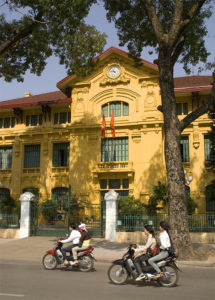
Hanoi’s colorful Communist Party Headquarters shuns the Stalinist style. Photo by Dennis Cox/WorldViews.
Oliver Stone’s 1986 film “Platoon” delivers one version of what that might have been like. Spike Lee’s recently released “Da 5 Bloods” delivers another. Lee does a masterful job of illustrating just how deeply personal the in-country experience was, in his telling, for a close-knit band of African-Americans.
In these times of Black Lives Matter, Lee reminds us that a disproportionate number of those who fought and died in Vietnam were individuals of color – and that many who survived carry scars, physically and emotionally, to this day.
But for many Boomers there was a war at home, too.
An anti-war movement demonstrated, at times violently, on college campuses and marched on city streets from Boston to Berkeley. Vietnam to this cohort became a symbol of American hubris and over-reach.
No matter your politics, if you came of age in the 1960’s and early ‘70’s, the war left its mark. It also left some gaping holes behind; in my little town of Ipswich, Massachusetts, I personally knew three kids — Paul, Bobby and Arthur — who never made it back.
The Horror
I was one of the protesters. As the fates would have it, I drew a draft lottery number that kept me out of harm’s way. The closest I ever came to Vietnam was a 1981 visit to Francis Ford Coppola’s decaying “Apocalypse Now” sets, erected in the Philippines to mimic Vietnam and Cambodia.
But here I was, in Hanoi, in 2020. Unlike Saigon, which was depicted frequently in broadcast reports during the war years to the point of familiarity, Hanoi was, and remained, an unknown. Unknown that is, with one infamous exception, the Hoa Lo Prison – more commonly known as the “Hanoi Hilton.”
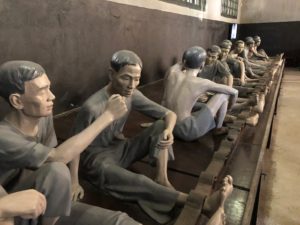
Mannequins represent Vietnamese shackled at notorious Hoa Lo prison under French rule. Photo by Robert Waite.
It is as good a place as any to start a visit.
The prison, now a museum, provides much needed perspective by putting U.S. Indo-China involvement into historic context. From 1896 to 1954 it was, according to one of its inmates, a French-administered “hell on earth in the heart of Hanoi.”
Every effort is made to drive home to visitors just how brutal the French colonial regime treated those who opposed their rule. In one large room, there is a depiction, using life-size mannequins, of prisoners packed tightly together and shackled at the ankles.
In another, you come face-to-face with France’s great gift to capital punishment, the guillotine.
Originally built to house 400-500 inmates, by the 1930’s as many as 2,000 were incarcerated.
It was a place of torture and death, but also served as a kind of revolutionary boarding school, planting the seeds of Marxist-Leninist thought among inmates.
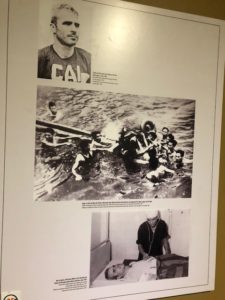
John McCain’s “rescue” and picture on display at the “Hanoi Hilton” prison.. Photo by Robert Waite.
One section is dedicated to what the Vietnamese call “The American War,” replete with photos and memorabilia, including John McCain’s flight suit and photographs of him being taken prisoner (“rescued” in the words of the caption) after his plane crashed into Truc Bach Lake.
A photo depicts U.S. pilots “enjoying” Christmas in the prison. To say the smiles look forced would be an understatement.
Along with McCain, scores of other Americans held in Hoa Lo prison between 1964 and 1973 were tortured. But what the Vietnamese seem to be saying is “it was worse for us under the French.”
Mixed Bag of Architecture
There is much to do and see in Hanoi beyond the “Hilton.” Although the city still retains some beautiful French colonial buildings — such as its Opera House — it also displays some of the drabness one associates with communist regimes.
A good example is the Stalin-era architectural style used in constructing Ho Chi Minh’s Mausoleum. Ho reportedly wanted a simple cremation; what he got was a massive marble edifice and a permanent resting spot under glass.
Having seen Mao under glass in Beijing years before, I decided to skip going in. But you may wish to brave the lines to see “Uncle Ho.”
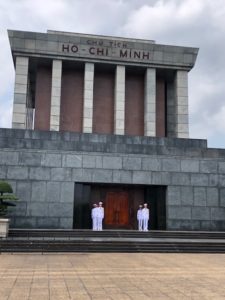
The Ho Chi Minh Mausoleum in Hanoi. Photo by Robert Waite.
Fast-Growing Economy
If Hanoi went through its Stalinist period in the 1950’s and ‘60s, today it is definitely trying to emulate China. The regime still holds the reins of power tightly, but economic hustle and consumerism is evident wherever you turn.
Old photos show tree-lined city streets filled with bicycles. Today streets – and sidewalks – are choked with fume-spewing motorbikes.
Many people wear masks, not just for fear of COVID or flu, but simply to filter out the grit and grime. It may be that we were caught in an inversion and the smog conditions were unusual — but be forewarned (and bring your mask!).
There were areas affording respite, including Hoan Kiem Lake, where nearby traffic is banned from Fridays to Sunday. Among other things, you can witness older residents practicing t’ai chi along the shore.
Another interesting activity to take in is a Water Puppet performance.
This art form was originally devised by northern farmers and the story lines are easy to follow — often featuring a dim-witted farmer and his hectoring (and smarter) wife.
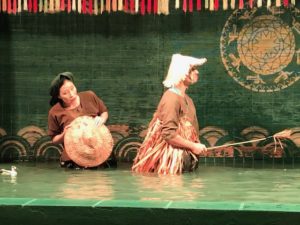
One of Hanoi’s colorful water puppet theaters. Photo by Robert Waite.
Much of the action takes place in the water, where puppets are ingeniously manipulated from beneath and behind. Live musical accompaniments, colored lights, and sparklers provide sound and visual effects.
Another must in Hanoi is a visit to one of the city’s famous coffee bars. Forget Starbucks – these cozy places serve Vietnamese coffee typically with condensed milk, or with coconut, yoghurt or egg. The egg coffee is particularly good.
At one coffee bar, a young Vietnamese server sneered at a member of our party for no apparent reason, and subsequently spilled drinks on her in the stairway, seemingly on purpose. This was the only case of outward hostility that we experienced (though we couldn’t be sure it was anti-Americanism), and management professed regret.
Generally, the Vietnamese were gracious and friendly to us – more so than I think we expected, or perhaps deserved, given the history.
Bay Watch
Hanoi sports more museums, morning and night markets, and other attractions, but at some point you will want to forego the city and head to one of the country’s premier attractions: Halong Bay. This UNESCO heritage site features hundreds of karst limestone islands jutting out of an emerald-colored sea.
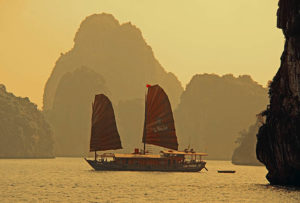
A traditional junk on Halong Bay in Vietnam’s Gulf of Tonkin. Photo by Dennis Cox/WorldViews.
It used to take four to five hours to go the 180 winding kilometers from Hanoi to Halong Bay, but today, thanks to the 2018 opening of a more direct highway, you can get there in half the time.
Your tour guide may well try to take you via the old route – he typically gets a commission from the shops and factories he takes you to along the way – but you would be wiser to skip all that and spend more time out on the water.
Haloing Bay is beautiful, even on overcast days, which was the weather for our visit. Ideally you will want to spend two nights on board one of the well-appointed vessels designed for sightseeing, as this will get you away from the mass of day-trippers and the unattractive port itself.
For those who have travelled to China, the surroundings are geologically reminiscent of Guilin – except that you are floating by the hills on the Gulf of Tonkin.
Places to visit on a bay cruise include fishing villages where you will likely see youngsters rowing small boats towards you as you approach, skillfully using their toes and feet to do so.
First-Class Cruise
On the ship itself the sleeping accommodations are comfortable – we were three in a reasonably spacious cabin – the food is fresh and tasty, and there are activities to keep you busy.

Cooking class aboard a Halong Bay cruise. Photo by Robert Waite.
For example, both evenings we took part in cooking classes (Vietnamese spring rolls were a hit) and at dawn I joined my disturbingly fit spouse and her even more fit sister on the deck to practice t’ai chi.
They say practice makes perfect, but there are photos of me writhing on deck that reveal that this can be a falsehood.
As previously noted, spending two days on the water makes all the difference – you get far enough away from the shore-side hurly-burly to enjoy something closer to the peace and tranquility that makes this seascape so special.
We arrived back in Hanoi refreshed and settled back into the comfort of the Metropole Hotel, in full knowledge that others of our generation – Vietnamese and American – had suffered greatly decades before to make that possible.
Next in Part II: Ho Chi Minh City (Saigon) and the Viet Cong Caves
IF YOU GO
Hanoi can be reached by numerous airlines; we arrived from Tokyo via Beijing on China Airways. Our arrangements were made by JBC Travel of Ottawa, Canada.
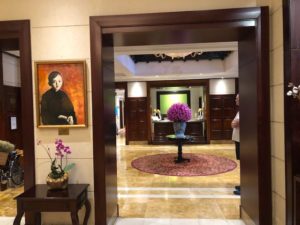
The lobby of the classic Metropole Hotel displays a painting by Joan Baez. Photo by Robert Waite.
We stayed at the Sofitel Legend Metropole Hotel, which we highly recommend. It combines classic French colonial design with all manner of modern amenities and has counted Graham Greene and Charlie Chaplin among its guests. The hotel conducts an excellent tour of the property for guests, which includes a visit to a “secret” bomb shelter beneath the bar (act surprised when they show it to you).
Also, in the lobby of the Metropole, you will see a striking painting of a Vietnamese child. It was painted by singer Joan Baez.
If you want to eat at the same local restaurant patronized by Barack Obama and the late Anthony Bourdain, head to Bun Cha Huong Lien. A picture of them enjoying the local cuisine and beer is displayed proudly on the wall above where they dined.
If Vietnamese coffee is your thing, a popular spot is Cafe Giang, which has been serving Joe hot and cold since 1946.
Of several Water Puppet Shows avaialble, we would recommend Lotus Water Puppet (aka Bong Water Puppet) at the Municipal Water Puppet Theater.
For your Halong Bay visit, the Au Co Cruise line is well organized both on shore and on the water.
Author Bio: Contributing writer Robert Waite has written on travel for nearly 50 years; his previous posts for clarknorton.com include such far-flung destinations as Namibia, Rwanda, Albania, Cambodia (Angkor Wat), Laos, and Guatemala. He is also a professor at Seneca College in Toronto and Managing Partner at Waite + Co., a communications consulting firm with offices in Boston, Ottawa and Toronto.
You might also enjoy an earlier five-part series, “Vietnam Diary,” by guest contributor Myles Stone, starting with “The Local Fixer,” a neighborhood fixture in Hoi An, Vietnam, where Stone, a physician, worked for several months.












4 Responses to Vietnam Visit Stirs Emotions for Boomers